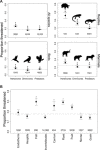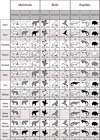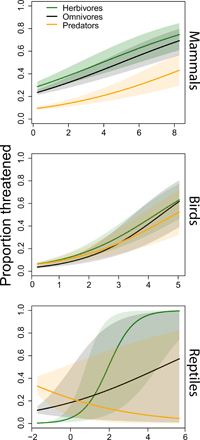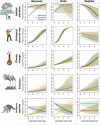Herbivores at the highest risk of extinction among mammals, birds, and reptiles
- PMID: 32923612
- PMCID: PMC7457337
- DOI: 10.1126/sciadv.abb8458
Herbivores at the highest risk of extinction among mammals, birds, and reptiles
Abstract
As a result of their extensive home ranges and slow population growth rates, predators have often been perceived to suffer higher risks of extinction than other trophic groups. Our study challenges this extinction-risk paradigm by quantitatively comparing patterns of extinction risk across different trophic groups of mammals, birds, and reptiles. We found that trophic level and body size were significant factors that influenced extinction risk in all taxa. At multiple spatial and temporal scales, herbivores, especially herbivorous reptiles and large-bodied herbivores, consistently have the highest proportions of threatened species. This observed elevated extinction risk for herbivores is ecologically consequential, given the important roles that herbivores are known to play in controlling ecosystem function.
Copyright © 2020 The Authors, some rights reserved; exclusive licensee American Association for the Advancement of Science. No claim to original U.S. Government Works. Distributed under a Creative Commons Attribution NonCommercial License 4.0 (CC BY-NC).
Figures






References
-
- IUCN, The IUCN Red List of Threatened Species. Version 2019–2 (IUCN, 2019); http://www.iucnredlist.org.
-
- McCauley D. J., Pinsky M. L., Palumbi S. R., Estes J. A., Joyce F. H., Warner R. R., Marine defaunation: Animal loss in the global ocean. Science 347, 1255641 (2015). - PubMed
-
- Young H. S., Mccauley D. J., Galetti M., Dirzo R., Patterns, causes, and consequences of Anthropocene defaunation. Annu. Rev. Ecol. Evol. Syst. 47, 333–358 (2016).
-
- Barnosky A. D., Koch P. L., Feranec R. S., Wing S. L., Shabel A. B., Assessing the causes of late Pleistocene extinctions on the continents. Science 306, 70–75 (2004). - PubMed
-
- Urban M., Accelerating extinction risk from climate change. Science 348, 571–573 (2015). - PubMed
Publication types
MeSH terms
LinkOut - more resources
Full Text Sources
Research Materials

